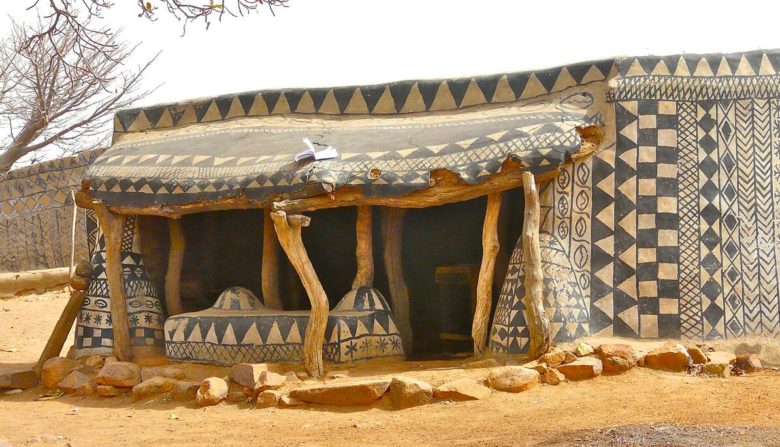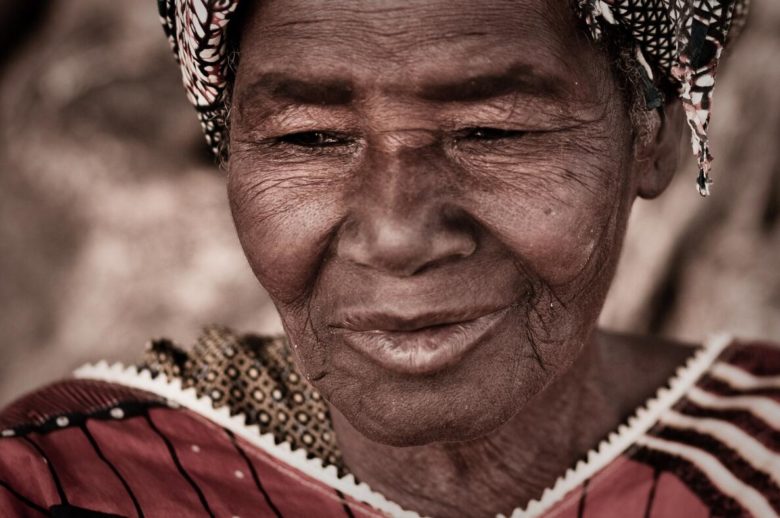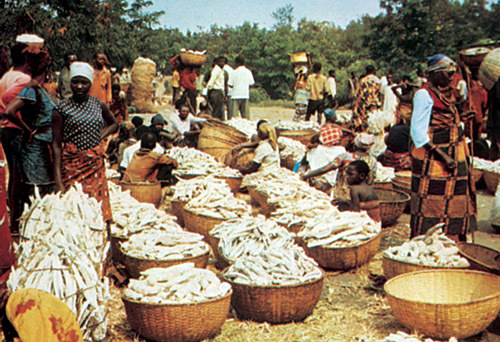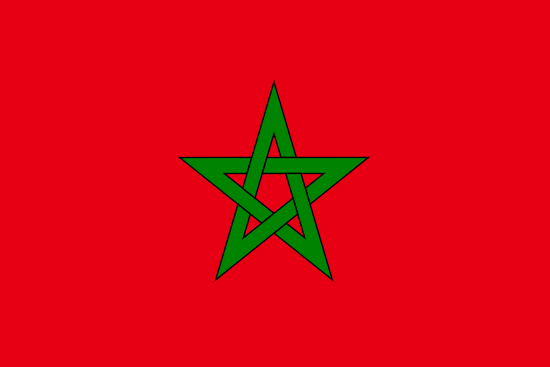Burkina Faso
Burkina Faso, Republic of West Africa, inland. The country borders Mali in the west and north, Niger in the east, Benin in the southeast, Togo and Ghana in the south and Ivory Coast in the southeast.
Most of the inhabitants are employed in agriculture. The country is one of Africa’s poorest, has limited natural resources and is exposed to drought. It became independent as Haute Volta ( Upper Volta ) in 1960 and got its current name in 1984. The capital is Ouagadougou.
Burkina Faso (the name) means ‘the land of the upright (or honest) men’.
National anthem is ‘Une Seule Nuit’ (‘A Single Night’).
Geography and environment
Most of the country is a bedrock plateau 200–300 meters above sea level. The plateau slopes slightly to the south and is intersected by the rivers Nakambé (White Volta), Nazinon (Red Volta) and Mouhoun (Black Volta). The highest point is the hill Tena Kourou, 747 meters above sea level, furthest west on a sandstone plateau bounded to the south and southeast by the 150-meter-high steep edge Falaise de Banfora.
In the north, dry savannah and semi-desert are part of the Sahel belt. Large areas have barren sand and laterite soils. There are numerous lakes. Rivers flood during the rainy season.
Among mammals there are, among other things, cat cats, red baboon, elephant, hippopotamus, lion, leopard, cheetah, coffee buffalo, spotted hyenas and African wild dog. Birds include vultures, eagles, beetles and weavers. There are crocodiles in the rivers. There are many species of snakes and lizards on the savannah.
Especially in the southeast, the tsetse fly is common.
In the south there is a relatively dry tropical savanna and in the Sahel belt in the north dry savanna and semi-desert. In many areas, plant life is strongly influenced by human activity and grazing.
The climate is tropical with two seasons. In the south, the dry season lasts from December to February, further north from November to April. The rainy season is usually from June to September. The annual rainfall is about 200 millimeters to the south and decreasing to the north. Warm desert winds highlight the dryness of the landscapes. In the north, temperatures are high, 5–47 o C. The country was severely hit by the drought disaster in the Sahel in the 1970s.
People and society
Most Burkins live south and central in the country. The area around the capital is most densely populated. Northern and eastern parts of the country are sparsely populated. Mossi make up 52.5 percent of the population (2010), and there are several ethnic groups, such as bobo, senoufo and gourounsi in the southwest and fulani in the north. 29.9 percent of the population is urban (2015), and more than 65 percent are under 25 years of age. Both population growth and child mortality are high. The health and sanitation conditions are poor.
Life expectancy at birth is 57.6 years for women and 55.5 years for men (2016).
French is the official language. 90 percent of the population speak Sudanese languages.
Life expectancy at birth is 57.6 years for women and 55.5 years for men (2016).
Muslims make up 61.6 percent, Catholics 23.2 percent and Protestants 6.7 percent of the population (2010).
State and politics
Under the Constitution, Burkina Faso is a “revolutionary, democratic, unitary and secular” republic. The president is elected in the general election for 5 years and can be re-elected once. The National Assembly has 111 members elected for 5 years. In addition, there is a constitutional chamber with 10 members and an economic and social council which is consultative.
The government is unstable and disputed because of allegations of interference with other countries’ conflicts. Political freedom is limited in Burkina Faso.
The country is divided into 13 administrative regions with 45 provinces and 351 municipalities.
It is voluntary military service. The army consists of about 6,000 and the air force of 200 men. In addition, there are 4200 semi-military forces and a people militia of about 45,000 men.
Burkina Faso is a member of the UN and most of the UN’s special organizations, such as the World Bank and the World Trade Organization and the Organization of African Unity (OAU), the Economic Community of the West African States (ECOWAS) and the Cotonou Agreement.
History
Several mossi kingdoms dominated the territory from around the 1300s to the end of the 19th century. From 1904 it was part of French Sudan and in 1919 was separated as a separate colony, Haute Volta (Upper Volta). In 1958, Upper Volta became an autonomous republic within the French Commonwealth and became an independent republic in 1960.
The time that followed was characterized by unstable political conditions with only periodic free political activity and several military coups. Captain Thomas Sankara became president in 1983, and the following year Upper Volta changed its name to Burkina Faso and the country changed its flag.
In 1985, there was a brief war against Mali. Sankara was killed in a coup in 1987 and Blaise Campaoré took power. He dominated the country’s politics, which were still characterized by arbitrariness and violence. Compaoré resigned as president in 2014 following popular protests against his attempts to change the constitution’s limitation to two presidential terms.
Following a failed coup attempt in October 2015, Roch Marc Christian Kaboré (1957–) was elected President the following month.
Economy and business
The most important trade route is agriculture, which employs about 80 per cent of the population and makes up 32.9 per cent of the gross domestic product (GDP) in 2015. Feeding is the most important. Among other things, it is grown millet, rice, manioc, taro, cotton and peanuts. There are deposits of gold, silver, lead, nickel, titanium, zinc, vanadium, manganese, phosphate and bauxite. Meat, hides, skins and gold are the most important export goods.
The industry is underdeveloped and mainly located in the two largest cities, Ouagadougou and Bobo-Dioulasso. Agricultural products are processed and manufactured, including textiles and footwear. Industry accounts for 21.9 per cent of GDP (2015).
The service industries make up 45.2 per cent of GDP (2015).
Hundreds of thousands of Burkins travel annually to Ivory Coast and Ghana to take seasonal work. In 1969, Ghana expelled 250,000 Burkinians.
Knowledge and culture
There is compulsory schooling with 6-year primary school for children aged 6-16, but this is not enforced. Only about 40 percent of children of primary school age attend school, and about 8 percent continue in high school. French is the language of instruction. More boys than girls go to school. There are universities in Ouagadougou and Koudougou, and polytechnic university in Bobo-Dioulasso.
There are six daily newspapers in Burkina Faso. The country’s most important media provider is the state-sponsored television and radio service RadioDiffusion-Télévision Burkina (RTB). There are many private radio stations.
The literature is based on oral tradition that is still alive and influences writers. The country’s first novel was written by Nazi Boni in 1962. Other famous authors include Norbert Zongo (1949–1988), Titinga Frédéric Pacéré (1943–) and Sarah Bouyain (1968–) who are also filmmakers.
Mask art is important in the mossi, bwa, winiama and bobo cultures. A renowned contemporary artist is Suzanne Ouedrago (1975–). The village of Tiebele is known for traditional architecture and hand-decorated houses.
Traditional instruments include the string instruments kora and n’goni, and drums. The annual festival ‘Jazz à Ouaga’ was created in Ouagadougou in 1992. Popular music is performed in French.
There is a state-organized film production, and the Ouagadougou biennial FESPACO is organized. A central director is Gaston Kaboré.




